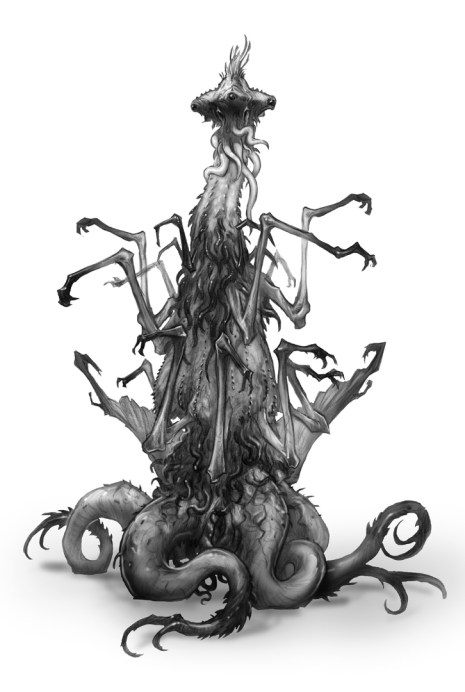
An “old” park poster showing tears and fold lines
Mystery Flesh Pit National Park
World concept by Trevor Roberts
Begun 2019
This is a different kind of review as it’s not for a book, movie, or game, but a shared concept world.
The Mystery Flesh Pit is the creation of Trevor Roberts, a concept artist and writer who started playing around with the idea on a Reddit forum on worldbuilding. The world is our own, but with a difference. Sometime in the early 1970s a mining company, Anodyne, discovered a titanic alien life form living within the mantle of the Earth. And by titanic I mean titanic; no one knows how deep it extends into the Earth’s mantle or how far its many branches spread. One of the ideas Roberts plays with, but leaves unsaid, is that the fact that it’s so huge humans cannot even begin to understand its true form or the function of its many strange organs. (I mean, the thing has ocular organs — eyeballs of a sort — that are a kilometer in size.) This makes it cosmic horror akin to Lovecraft’s idea of huge cosmic beings indifferent to mankind or the unseen visitors of Roadside Picnic whose visit to Earth is never explained, nor are the objects they left behind. The site is equal parts Roadside America, Fantastic Voyage, Body Horror, and The Missing 411, and the informative yet bland pictures and prose of US government brochures.
I’ll let the author himself explain the basics.
 |
The Mystery Flesh Pit is the name given to a bizarre natural geobiological feature discovered in the Permian Basin region of west Texas in the early 1970s. The pit is characterized as an enormous subterranean organism of indeterminate size and origin embedded deep within the earth, displaying a vast array of highly unusual and often disturbing phenomena within its vast internal anatomy.
Following its initial discovery and subsequent survey exploration missions, the surface orifice of the Mystery Flesh Pit was enlarged and internal sections were slowly reinforced and developed by the Anodyne corporation which opened the Pit as a tourist attraction in 1976. In the early 1980s, the site was absorbed into the National Park System which operated and maintained the Mystery Flesh Pit until its sudden closure in 2007. |
 |
Given this framework, the Tumblr site consists of series of ephemera, as if someone had been saving for decades printed material (and a few objects, such as signage) about this place. It is the objects that tell the story. For example this sign:

A sign based on ones you might find in Yellowstone National Park, where the unwary could be cooked alive in hot springs or dissolved in mineral pools.
… tells the reader way more about the place than any amount of printed word could.
But that’s not all. An integral part of the site is the subreddit it has generated, which invites readers to join in on the fun with their own artistic creations, theories, questions, and even “memories” of experiencing a family trip to the park as a child. This adds to the strange feeling of dislocation, as many of the remembrances sound no different from any other forum chatter about some long-vanished attraction, save it took place inside a giant alien being.
Indeed, the whole world could be taken as a cautionary tale about normalizing the monstrous and how insidious it is. Readers of both sites are reminded again and again of how dangerous the place is, yet the neutral, helpful, anodyne (like the name of the mining company which founded the park) tone of the brochures and signage speak soothingly to us, overriding the truth. And there are kernels of truth in there to be found in there: corporate greed for one.
This world is still growing and expending, the author purposefully keeping back information which leads to speculation and interest. It already has a thriving mythology, like the mysterious amniotic fluid stomach chambers that contain a liquid that stimulates the libido, whale-sized creatures that swim in the gastric sea, and deformed humans that live deep in the creature’s innards. The nature of the being itself is still mysterious. It has red blood and breathes oxygen, but that’s all that’s known about it, apparently.
If you’re into something different, and want to be immersed in a world but not necessarily a plot and characters, check out the MFP.





 In the modern Western world, any symbol with a human eye on it is unsettling. In America, there is one on our currency: a Masonic one, if rumor is to be believed, of an all-seeing eye stop a pyramid. Perhaps it’s a reminder of a pagan past Christianity has tried hard to stomp out, an era of gods in the form of an all-seeing eye, and eyes as amulets and charms working to protect the wearer against another form of supernatural eye, the Evil Eye. What was once a valid symbol of protection has become primal and horrifying.
In the modern Western world, any symbol with a human eye on it is unsettling. In America, there is one on our currency: a Masonic one, if rumor is to be believed, of an all-seeing eye stop a pyramid. Perhaps it’s a reminder of a pagan past Christianity has tried hard to stomp out, an era of gods in the form of an all-seeing eye, and eyes as amulets and charms working to protect the wearer against another form of supernatural eye, the Evil Eye. What was once a valid symbol of protection has become primal and horrifying.
















































